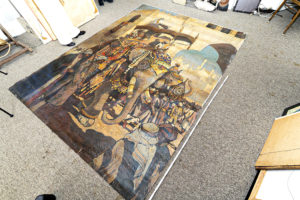Are you an Artist? Then this Appraiser wants to speak to you about selling in today’s art MARKET.
WHAT is your strategy for SELLING your art?
 I’m a career Appraiser these past 20 years and I approached selling in today’s art market for artists at a collective in Santa Barbara CA. This article compiles my thoughts on this topic for the career artist. I gathered them from questions from the Santa Barbara artists that evening, as well as my educated opinion about selling YOUR ART in today’s market.
I’m a career Appraiser these past 20 years and I approached selling in today’s art market for artists at a collective in Santa Barbara CA. This article compiles my thoughts on this topic for the career artist. I gathered them from questions from the Santa Barbara artists that evening, as well as my educated opinion about selling YOUR ART in today’s market.
The epic tension in the creative lives of many artists is between what you KNOW will sell, and the work you WANT to create. Both art produced for a known market, and art created for an unknown market, beg the age-old question of pricing. Later in this article I suggest a technique for pricing work based on appraisal methodology. Also I address the headache, and heartbreak, of pricing work the market may NOT be ready for. Finally, I offer a recommendation based on the principle of market diversity, something all appraisers are trained to research.
For years I visited galleries, artist’s studios, and attended gallery openings.
 So let me offer what I see WORKS in these places to encourage a sale. Perhaps the best example comes from my experience at Art Basel in Miami Beach, one of the biggest contemporary forums for high end sales. Many artists there let the public ‘in’ on something rather mysterious: THEIR OWN creative process. This takes the form of a well-produced and sexy ‘looping video’ of the artist at WORK, showing the process of making a piece.
So let me offer what I see WORKS in these places to encourage a sale. Perhaps the best example comes from my experience at Art Basel in Miami Beach, one of the biggest contemporary forums for high end sales. Many artists there let the public ‘in’ on something rather mysterious: THEIR OWN creative process. This takes the form of a well-produced and sexy ‘looping video’ of the artist at WORK, showing the process of making a piece.
I witnessed connoisseurs standing at an Art Basel booth watching an artist’s video. The viewer watched the process of painting, or pulling a print, or sculpting. They gawked, perhaps even before proceeding to LOOK at the work in the booth. Because the artist is so familiar with their own process, they forget the public simply doesn’t conceive WHAT it takes to paint, sculpt or make works on paper. SO, I suggest, SHOW THEM!
At another very well-known artist studio
 I was charged with finding value for a museum purchase. One artist presented a physical ALBUM showing lovely photos of clients who purchased his work, along with beautiful studio shots of the WORK itself. (Usually he also appeared in the shot.) How HAPPY his buyers looked with the acquisition impressed me, if the photos tell the story righteously! When he gets permission he puts such images in his online album. He told me he doesn’t necessarily TALK to buyers about his work upon a studio visit, he SHOWS them how enlivening others feel to OWN his work in these photos. Our present-day technology opens the whole field of using IMAGES to sell Images. And he takes full advantage of all the capabilities of his iPhone 6.
I was charged with finding value for a museum purchase. One artist presented a physical ALBUM showing lovely photos of clients who purchased his work, along with beautiful studio shots of the WORK itself. (Usually he also appeared in the shot.) How HAPPY his buyers looked with the acquisition impressed me, if the photos tell the story righteously! When he gets permission he puts such images in his online album. He told me he doesn’t necessarily TALK to buyers about his work upon a studio visit, he SHOWS them how enlivening others feel to OWN his work in these photos. Our present-day technology opens the whole field of using IMAGES to sell Images. And he takes full advantage of all the capabilities of his iPhone 6.
Artists often ask me how to go about selling work through an auction house so they establish auction house VALUES, which are public knowledge. The art world thinks of this as a pedigree of provenance. The Catch 22 is that unless an artist has sold at auction, an artist can’t usually BE SOLD at auction. Sadly, then, the artist must market their own works. This fact usually leads to another question from my artist friend….
About Gallery Representation
 How does an artist obtain representation in a GALLERY? This differs gallery to gallery, but to capture a gallery’s “interest,” perhaps use visual imagery –and use it WELL! I suggest the preparation of a fine digital portfolio, including images of the artist AT WORK.
How does an artist obtain representation in a GALLERY? This differs gallery to gallery, but to capture a gallery’s “interest,” perhaps use visual imagery –and use it WELL! I suggest the preparation of a fine digital portfolio, including images of the artist AT WORK.
Then, persistence is called for. The artist must ASK the gallery curator (sometimes repeatedly) to have a critical look at the work.
Here’s an important comment about selling in today’s art market:
An artist must CHOOSE the gallery to approach wisely, Usually galleries have a certain Market RANGE and STYLE they offer in works shown to their KNOWN customers. A gallery curator feels ‘put off’ if the artist has not researched the gallery’s previous “stable” of artists. Find a gallery that fits, I tell my artist friends, using an appraiser’s methodology of comparable sales in an ‘appropriate’ marketplace. More about that technique follows.
Major question asked of an appraiser speaking to working artists:
How does an artist CHOOSE a price point? I answer this question, again, using an appraiser’s methodology. Every artist’s portfolio usually contains about eight elements distinguishing a certain work. Thus, an artist can do their research like this appraiser does her research, by finding comparable sales to DISCOVER MARKET LEVEL.
The areas I look at for similarities in the existing art market are:
- Genre or style
- Color and textures
- Size and dimensions, including choice of mount
- Medium
- Skill level, including teachers and training
- Meaning of the imagery in the work, and range (if in a series) of the total work (called the oeuvre)
- Proportion, meaning the composition of the elements in the work
- Date of creation
 I also do research into the category or the TYPE of style. Does the work fall into an art market accepted category, such as abstraction, expressionism, impressionism, or conceptualism, to name a few. I like to remind my artist friends that all major auction house sales have TITLES based on these accepted styles, by which work has SOLD in the market. For example, a recent title at a big House: Important California Impressionist Art of the late 20th century. I’m not implying that every artist will compare their work with “Important” work, but that the art market’s buyers and sellers “think” in genres. So research into pricing must consist of the ‘areas of similarities’ into physical properties, as well as market conceptions of the STYLE of the work.
I also do research into the category or the TYPE of style. Does the work fall into an art market accepted category, such as abstraction, expressionism, impressionism, or conceptualism, to name a few. I like to remind my artist friends that all major auction house sales have TITLES based on these accepted styles, by which work has SOLD in the market. For example, a recent title at a big House: Important California Impressionist Art of the late 20th century. I’m not implying that every artist will compare their work with “Important” work, but that the art market’s buyers and sellers “think” in genres. So research into pricing must consist of the ‘areas of similarities’ into physical properties, as well as market conceptions of the STYLE of the work.
If an artist identifies other artists’ work with at least six areas of similarity to the eight areas above, including style and genre, and that artist has SOLD work, invest a good amount of hard research into the price this discoverable work SELLS for. That ‘range of values’ becomes an artist’s bellwether for pricing their own work. If a similar body of work sells only at that artist’s galleries, the researcher subtracts a chunk – sometimes up to one half of selling price, from the prices PAID. And, as an appraiser, I always counsel researching artists to find actual Sales, not prices OFFERED!
Another thorny question I receive from artists
 How BEST to sell within today’s competitive and celebrity driven marketplace? An artist must think like a capitalist, as hard as that may seem! Offer your public a RANGE of price points at which to BUY. This is a tried and true marketing method in the commercial world. Think of airlines that offer a range of seats which differ not necessarily in space purchased, but in PRICE, and perception of value.
How BEST to sell within today’s competitive and celebrity driven marketplace? An artist must think like a capitalist, as hard as that may seem! Offer your public a RANGE of price points at which to BUY. This is a tried and true marketing method in the commercial world. Think of airlines that offer a range of seats which differ not necessarily in space purchased, but in PRICE, and perception of value.
One artist I counseled offers 10 x10” acrylics on board at under $200 each, shown strategically alongside a large work (oil on canvas) selling for $14,000. He offers giclées pulled from some of his work. Also he offers unframed work in his smaller oils on canvas series, and he switches up media, offering lower priced woodcuts. No one leaves his studio without at least considering an affordable purchase. And, if he makes a sale, no matter how inexpensive, he believes he gained a client for LIFE. He takes names and keeps in touch with an occasional newsletter that SHOWS, with great photos and short videos, what series he presently is creating. He SHOWS the magic of his creative process in each newsletter produced.
The Bottom Line About Selling in Today’s Art Market
 Since artists are by nature VISUAL people, they need to offer their prospective clients photographic VISUAL IMAGERY of their unique creative process. Teasers, you might say, in photo documentation of their work in progress. Folks indeed feel intrigued and fascinated by the mysterious world of creation. So an artist’s job becomes SHOWING ‘perception’ at work.
Since artists are by nature VISUAL people, they need to offer their prospective clients photographic VISUAL IMAGERY of their unique creative process. Teasers, you might say, in photo documentation of their work in progress. Folks indeed feel intrigued and fascinated by the mysterious world of creation. So an artist’s job becomes SHOWING ‘perception’ at work.
Finally, as an appraiser I see relative price points at which any artist might sell. An artist might offer a variety of prices for a VARIETY of work. If you’re an artist, perhaps present an entry level size and medium work for clients, and see if you make a lifelong collector out of that first one affordable purchase.
Excellent advice. I immediately see the value of the loopig video of the artist at work and the image of a happy client with the art and artist. Thank you, Elizabeth, Betsy Gallery
Pingback: An Appraiser Speaks to the Frustrated Artist Part 1 - Elizabeth Appraisals
Pingback: An Appraiser Speaks to the Frustrated Artist Part 2 - Elizabeth Appraisals
Pingback: 80s Mixed Media Flowed From Mentorship - Elizabeth Appraisals